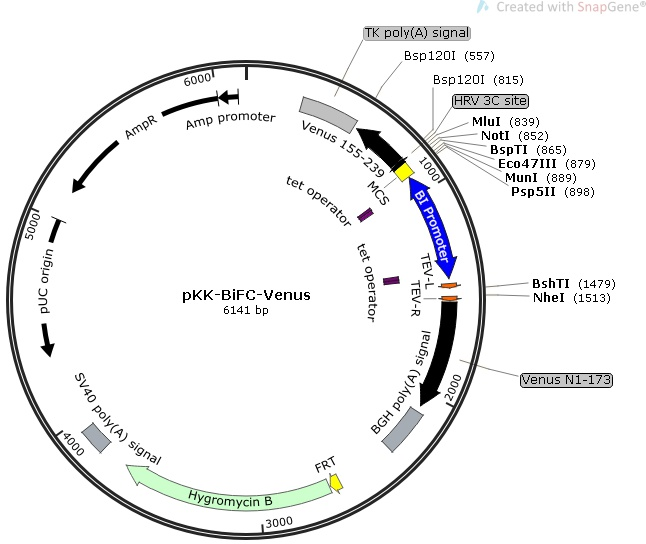-
Purpose(Empty Backbone) Concomitant expression of two proteins in fusion with fragments of Venus protein. Protein interactions studies by bimolecular fluorescence complementation (BiFC), including BiFC-FRET assays.
-
Depositing Lab
-
Sequence Information
Ordering
| Item | Catalog # | Description | Quantity | Price (USD) | |
|---|---|---|---|---|---|
| Plasmid | 105804 | Standard format: Plasmid sent in bacteria as agar stab | 1 | $85 | |
Backbone
-
Vector backboneBI-16 (constructed based on pcDNA5/FRT/TO from Invitrogen)
-
Backbone manufacturerSammarco & Grabczyk (PMID: 16212928)
-
Vector typeMammalian Expression ; Flp-In competent
-
Selectable markersHygromycin
-
Tag
/ Fusion Protein
- VN173 (I152L); VC155 (C terminal on backbone)
Growth in Bacteria
-
Bacterial Resistance(s)Ampicillin, 100 μg/mL
-
Growth Temperature37°C
-
Growth Strain(s)DH5alpha
-
Copy numberHigh Copy
Gene/Insert
-
Gene/Insert nameNone
-
Tag
/ Fusion Protein
- VN173 (I152L); VC155 (C terminal on backbone)
Resource Information
-
Supplemental Documents
-
Article Citing this Plasmid
Terms and Licenses
-
Academic/Nonprofit Terms
-
Industry Terms
- Not Available to Industry
Trademarks:
- Zeocin® is an InvivoGen trademark.
Depositor Comments
Addgene has found the VN173 mutation (I152L) is not present in this plasmid.
This vector is a member of the pKK vector family. It enables concomitant expression of two genes, which transcription is driven by a tetracycline responsive bidirectional CMV promoter. This vector is a derivate of the BI16 plasmid (PMID: 16212928) and is suitable for stable cell line generation using the Flp-In system (see Szczesny RJ et al. for detailed description and protocols; bioRxiv, doi: https://doi.org/10.1101/160101) pKK-BiFC-Venus vector encodes fragments of Venus (VN173, VC155) that become fluorescent when they reassemble into full fluorescent protein. Thus, it is useful for protein-protein interactions studies involving bimolecular fluorescence complementation approach (BiFC) (PMID: 16454041, 18846096). Here, an improved version of VN173 fragment is used (I152L) to inhibit self-assembly (PMID:21091444). Venus fragments coding sequences were cloned from Addgene ID: 22010 and 22011 and VN173 was subjected to site-directed mutagenesis to introduce mutation I152L.
These plasmids were created by your colleagues. Please acknowledge the Principal Investigator, cite the article in which the plasmids were described, and include Addgene in the Materials and Methods of your future publications.
-
For your Materials & Methods section:
pKK-BiFC-Venus was a gift from Andrzej Dziembowski (Addgene plasmid # 105804 ; http://n2t.net/addgene:105804 ; RRID:Addgene_105804) -
For your References section:
Versatile approach for functional analysis of human proteins and efficient stable cell line generation using FLP-mediated recombination system. Szczesny RJ, Kowalska K, Klosowska-Kosicka K, Chlebowski A, Owczarek EP, Warkocki Z, Kulinski TM, Adamska D, Affek K, Jedroszkowiak A, Kotrys AV, Tomecki R, Krawczyk PS, Borowski LS, Dziembowski A. PLoS One. 2018 Mar 28;13(3):e0194887. doi: 10.1371/journal.pone.0194887. eCollection 2018. 10.1371/journal.pone.0194887 PubMed 29590189






